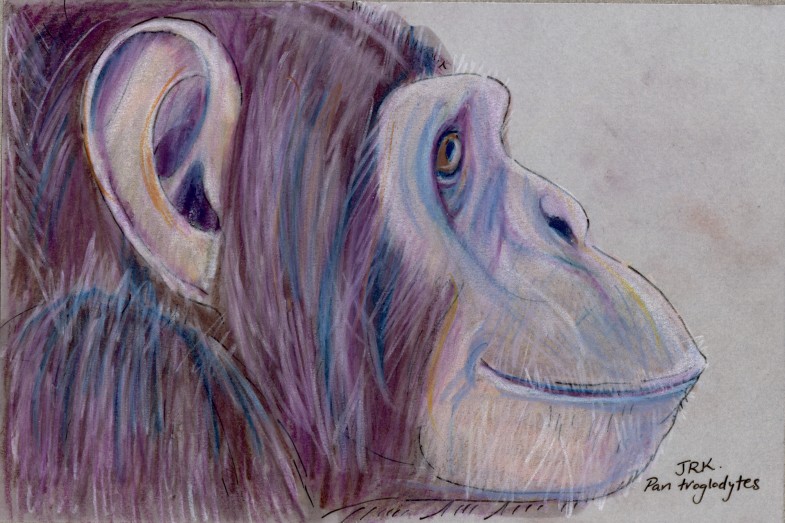Repeat: Common Chimpanzee (Pan troglodytes)
Until February 24, 2011, I hadn’t posted a mammal since July 10, 2010. Why? Well, the kids kept me busy, and that’s an understatement. Most of it was just general exhaustion. But I was also a bit burned out after my World Cup series, a month-long extravaganza of mammals that involved a whole lot of research about soccer and different countries in addition to the standard mammal research I do for each post. And it seems I had reached a tipping point at which I had drawn all of the mammals most people had heard of, so that people say, “Oh, you should draw a giraffe!” or an armadillo or even an aye-aye or pygmy mouse lemur or dog or human, and I always have to say, “I already drew it.” Every time I run across an interesting article about mammals, I’ve already drawn all the mammals mentioned. It seemed I was in for a long—decades-long—slog of obscure rodents and hardly known bats and shrews.
Well, I am still in for that decades-long slog of lowly little furry things, but as I was reading an article in The New Yorker about bushmeat and the spread of viruses, regretting that I had already drawn the common chimpanzee, I decided, so what? Nobody is telling me I can’t draw it again if I want to, except myself, so why not? If it helps me stay interested in this project, I may as well do it, even if it puts off the project’s eventual completion. At this rate, I won’t finish until I’m in my late 80s anyway, so what’s the difference? So here is a chimpanzee (my drawing of which I like much less than my original chimpanzee drawing).
The New Yorker article I mentioned was “The Doomsday Strain” by Michael Specter and appeared in the December 20 & 27, 2010, issue. (The link is to a PDF.) It’s about a scientist named Nathan Wolfe and his organization, Global Viral Forecasting, which seeks to predict and prevent future viral catastrophes. One thing they do is study bushmeat, which is wild animals killed for food, particularly in Africa. I’ve talked on this site before about bushmeat as a threat to animals—see the Bushmeat Crisis Task Force if you’d like more information about that—but it’s an equally dangerous threat to humans. In some parts of Africa—and other continents, but we’re talking about Africa here—bushmeat is the primary protein source that humans eat. Because they don’t have many alternatives, people will kill rodents, elephants, antelopes, monkeys, or apes and bring them home to their families. Sometimes they won’t even kill the animals but just pick up ones that have already died.
The hunting and the preparation of the carcasses are both very bloody enterprises, and nobody wears gloves or masks or protective gear. Through the hunting and eating of bushmeat, many viruses spread to humans, including HIV, which was probably first contracted by a human who killed, prepared, or ate a chimpanzee. Now that humans can travel over oceans and across continents without too much trouble, these viruses can spread out of Africa quickly.
Here is a video from Anderson Cooper that features Nathan Wolfe and a lot of animal carcasses.


I like this new guy a lot. And interesting article.
Thanks, Grace! I’m glad you like it.
I made another change that y’all may have noticed. I’ve started writing the mammal’s scientific name on the drawing. It’s fine to think I won’t go another 8 months without posting, but just in case, I don’t want to be stuck with another mystery bat like the one I have in my possession now!
I absolutely LOVE this drawing you did of the chimpanzee. The composition is bold and exciting, the animal’s facial structure and expression are done beautifully, and the whole thing has such a delicate quality to it! I really do love it.
Having said that, though, looking back at your earlier chimp drawing, I’m at a loss to decide which I like better. I love the vibrant colors and detail of the hair in the earlier one, though I think this new one works overall as an expressive image better.
So they’re both winners, if you ask me!
well, I like them both very much. And the commentary is very interesting.
Girl, “slog of obscure rodents and hardly known bats and shrews” describes 98% of my friends, family and romantic interests (past and present). I say you jump into the rest of the project with both feet!!
That being said, there is value to repeats. Some people stage entire careers on drawing one kind of mammal, and most of that without your interesting commentaries. So let your muse guide you, and I’ll happily watch the outcome, whatever you decide. :)
Kate, thank you. As always, I’m so glad you visit the site and comment. It makes me so happy and proud that you like my work.
Alexandra, that’s so funny about your friends, family, and romantic interests! Thanks for the encouragement. I need it! I’m teetering between just packing it in and continuing, and it’s nice when new people pop in and say hi. Very good point about the value of repeats. I’m enjoying your blog, too!